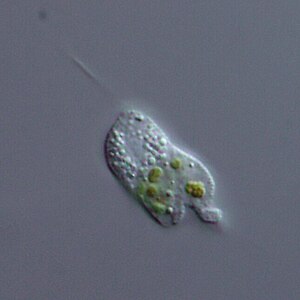Cercomonadida
| Cercomonadida | ||||||||||||
|---|---|---|---|---|---|---|---|---|---|---|---|---|

Cercomonas sp. |
||||||||||||
| Systematics | ||||||||||||
|
||||||||||||
| Scientific name | ||||||||||||
| Cercomonadida | ||||||||||||
| Poche , 1913 |
The Cercomonadida are an order of heterotrophic flagellates and are assigned to the Cercozoa .
features
The Cercomonadida are free-living ameboflagellates: at least some of the species alternate between the ameboid and flagellate form. They do not form a cell wall . They have two flagella that beat differently and that do not have mastigonemata . The anterior flagellum points forward and makes striking movements. The posterior flagella runs back along the ventral side of the cell. The pseudopodia occurring in many representatives serve for food intake, not as in many other amoebas for locomotion. Most species are relatively small at around 10 µm.
Some species have a complex life cycle in which multinucleated and multi-flagellated plasmodia occur. Some species also form cysts . The kinetosomes are connected to the nucleus . The mitochondria have tubular cristae . They have microbodies and various forms of extrusomes .
Distribution and habitats
The Cercomonadida are distributed worldwide. They can be found in salt, brackish and fresh water, also in anoxic habitats such as sewage treatment plants. They are also found on the microbial mats around stromatolites . The genera Cercomonas , Heteromita and Allantion are also very widespread in soils and form up to half of the total protozoal biomass in the soil. Often, however, the Cercomonadida are overlooked due to their small size.
Systematics
The Cercomonadida were established by Poche in 1913, replaced the Rhizomastigina by Bütschli and only contained the genus Cercomonas . K. Vickerman expanded the diagnosis in 1983 so that the order now also included heteromita . Another revision of the diagnosis was made in 1986 by Mylnikov. For a long time the affiliation of the genera Cercomonas, Heteromita, Bodomorpha, Helkesimastix and Massisteria to the order was undisputed, the new description of some genera as well as molecular biological results led to some changes. Mylnikov and Karpov (2004) set out the following systematics in their review, which were essentially also used by Adl et al. 2005 was taken over:
- Family Cercomonadidae : the representatives have a variable body shape, habitually form pseudopodia, form a microtubule cone and the extrusomes have microtoxicysts, trichocyst-like structures and osmiophilic bodies. Some forms form plasmodia.
- Family Heteromitidae : the representatives have a fixed body shape, form pseudopodia for a limited time. Microtubule cones and pseudopodia are absent. As Extrusomen be Kinetozysten formed.
Proleptomonas and Mallisteria are no longer assigned to the Cercomonadida, but assigned as incertae sedis to the next higher taxon Cercozoa. Bodomorpha was incorporated into Cercomonas .
The two families are also separated in cladistic analyzes. The sister group of the Cercomonadida should be the Silicofilosea .
supporting documents
- Sina M. Adl et al .: The New Higher Level Classification of Eukaryotes with Emphasis on the Taxonomy of Protists. In: The Journal of Eukaryotic Microbiology. Vol. 52, No. 5, 2005, pp. 399-451. doi : 10.1111 / j.1550-7408.2005.00053.x .
- Alexander P. Myl'nikov, Serguei A. Karpov: Review of diversity and taxonomy of cercomonads. In: Protistology. Vol. 3, No. 4, 2004, ISSN 1680-0826 , pp. 201-217, online (PDF; 249 kB) .
Individual evidence
- ↑ Thomas Cavalier-Smith, Ema E.-Y. Chao: Phylogeny and Classification of Phylum Cercozoa (Protozoa). In: Protist. Vol. 154, No. 3/4, 2003, pp. 341-358, doi : 10.1078 / 143446103322454112 .